- Home
- Lesson Ideas
- Vocabulary Lesson on Clothes and Fashion Combined with Productive Skills - Writing and Speaking
Vocabulary Lesson on Clothes and Fashion Combined with Productive Skills - Writing and Speaking
Lydia Ciola is a student at UCLL in Diepenbeek, Belgium. She is interested in languages, the Bible, nature, doing handicrafts and cooking and baking. Current professional interests are teacher training periods in different secondary schools and a week of voluntary work in a camp for children with autism. She also likes reading in her free time, especially English classics (Charles Dickens, L.M. Montgomery.) Enjoys working with pupils (preferably ages 12-14) and weaker pupils who need a lot of support in their learning process.
Email: lydia.ciola@student.ucll.be
Lesson plan/ project
Introduction (5 minutes)
The teacher puts some pictures of people wearing different outfits in different clothing styles on the blackboard. The pupils have to come to the front and stand in front of the pictures they like the best. The pictures are the following:
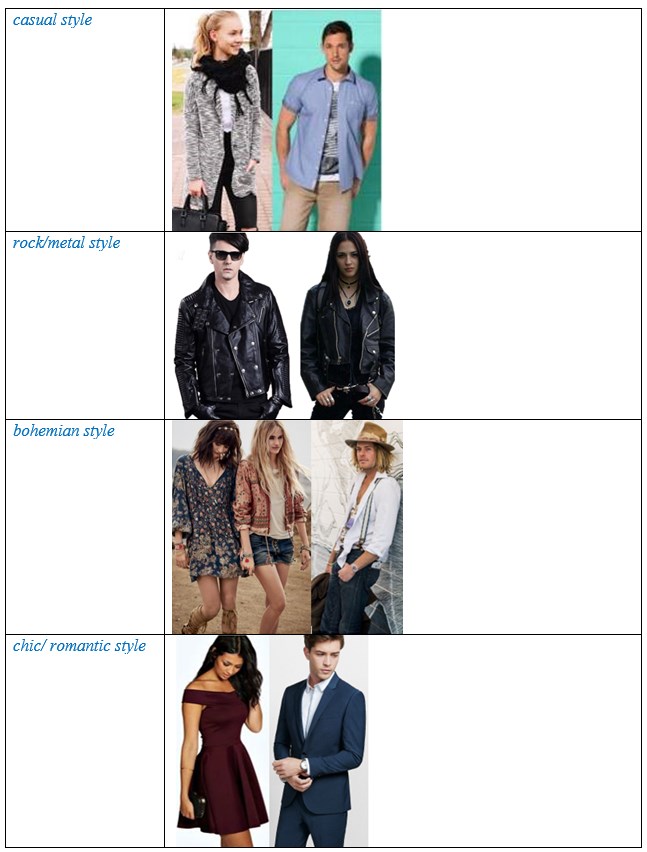
After the pupils have chosen some pictures and a clothing style, the teacher asks a few pupils why they chose those pictures or that specific style. Then, the teacher asks the pupils if they have a question for a classmate who likes another clothing style than they do. This way the pupils have a short class discussion about different clothing styles and why people like them.
Lesson proper
- Presentation (10 minutes)
The teacher presents the new vocabulary by showing and discussing pictures in a PowerPoint presentation. The teacher asks a lot of questions about the vocabulary, so the pupils will remember the words in a better way.
Functional clothing
- The first item is an apron. Why would you wear an apron?
To protect your clothing from getting dirty.
- Who would wear an apron? Give some examples of people who would wear it.
A cook, someone who is cleaning the house …
- In the second picture we see a bow tie. Who would wear this and why?
Men, when they are wearing a suit to go to a party or an important event. A clown, because it is part of its outfit.
- Next, we have mittens. When do you wear these?
In the winter or when it is really cold outside.
- Why do you wear the mittens?
To keep your hands warm and cosy.
- In the next picture we see a pair of sandals. Who could wear this pair?
A girl or a woman.
- Of course there are sandals for men too. When do people wear sandals?
They wear them in the summer, when the weather is nice.
- In the following picture, you see a dressing gown. When do people wear it and why?
When they get up in the morning to keep themselves warm.
- The next item is a helmet. Who wears a helmet? And why do they wear it?
Cyclists wear it to protect their head in case they would fall.
- A lifejacket is the next one. When would you wear one and why?
On a boat trip. If you would fall in the water, you can’t drown.
- Next, we have a pair of trainers. What do you use these shoes for?
For running or training.
- In the following picture, you can see a wetsuit. When do you need this suit?
You have to wear a wetsuit for deep-sea diving.
- Last but not least, there is a tracksuit. Which clothing item could you wear together with a tracksuit? And when would you wear this outfit?
The trainers. You can wear this outfit for running or training.
Different types of fabric/material
The teacher quickly goes through the different types of fabric, together with the pupils.
Describing clothes
The teacher goes through some descriptions of clothes, together with the pupils.
For example:
- What can you say about the sleeves?
None, long or short.
- What can you say about the pattern?
Flowers, squares, no pattern, stripes.
- Practice (5 minutes)
Exercise 1
The pupils work in pairs. They have to describe the clothing of the person sitting next to them. They discuss their descriptions together.
The following questions might help the pupils: What is he/she wearing? Which fabrics are the clothing items made of? Which patterns do the items have? What about the length of the sleeves?
The teacher also gives an example by discussing his/her own outfit.
The teacher walks around, guides the pupils if necessary and listens to the conversations.
- Practice/production (30 minutes)
Exercise 2
This exercise is a combination of writing, speaking and art. The exercise is about the following storyline.
Storyline
You all work in a company that creates functional clothing. The pictures in the PowerPoint presentation were the first designs for the clothing items, but your boss isn’t happy with the way the items look. He wants all of you to create a new clothing line. Each team has to create three new pieces. You can choose which ones you want to recreate. Each member of your team has to take up a different role after you’ve brainstormed about your ideas.
For this exercise the pupils are divided into groups of four. In each group one person is the fashion designer, one is the reporter, one is the graphic designer and one is the representative. After working on each clothing item, the pupils are allowed to switch roles.
Roles
Fashion designer: you draw the different items with the colours and patterns you want the items to have. Make sure it looks good for your boss.
Reporter: you write down the descriptions of the clothing items. Make sure your boss knows which fabrics and materials you want to use and what the items will look like.
Graphic designer: you create the lay-out of the presentation of your clothing line. You can create a PowerPoint presentation or a magazine cover. Try to approach your target group.
Representative: you are the spokesperson of the group. You have to lay the ideas of your team in front of the boss and some other colleagues. They can ask you questions about your ideas.
The pupils get five minutes to brainstorm in their groups and to divide the roles.
The pupils get four minutes to create each clothing item. After each four minutes the representatives come together for a meeting. They present the idea of the first clothing item and they check each other’s texts for mistakes. While the representatives meet up, the other pupils work on the next clothing item. The third clothing item will not be discussed by the representatives, so that item will be the secret item.
Possible questions the representatives could ask during the meetings: Which clothing item did your group design? What does the clothing item look like? Which fabrics or materials will you use and why?
When all the teams are ready with their preparations, the representatives present the ideas of their teams to the other groups. Each group gets about two minutes to present their ideas. (10 minutes) Eventually the groups will vote on the best team. The team that has been voted on the most, will receive a raise (a prize: candy or something like that). (3 minutes)
Source
I used Tine Bergen, T.B., (2014) Shuffle this 3, die Keure, p. 192-195. workbook for the vocabulary list and some of the pictures used in the exercises. The pictures that I used in the lead-in do not come from this workbook.
Extra information
Prior knowledge
The pupils have already learnt some vocabulary about clothes and fashion. This means that they know the basic vocabulary to talk about clothes and fashion.
Extra
PowerPoint presentation
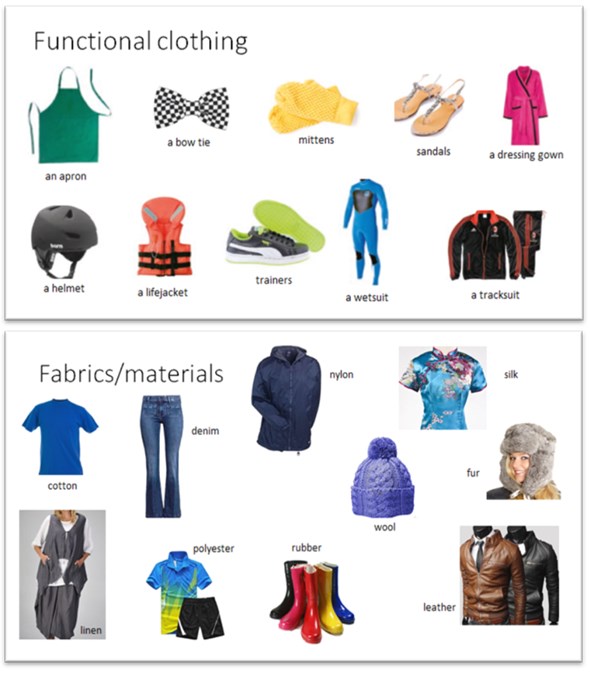
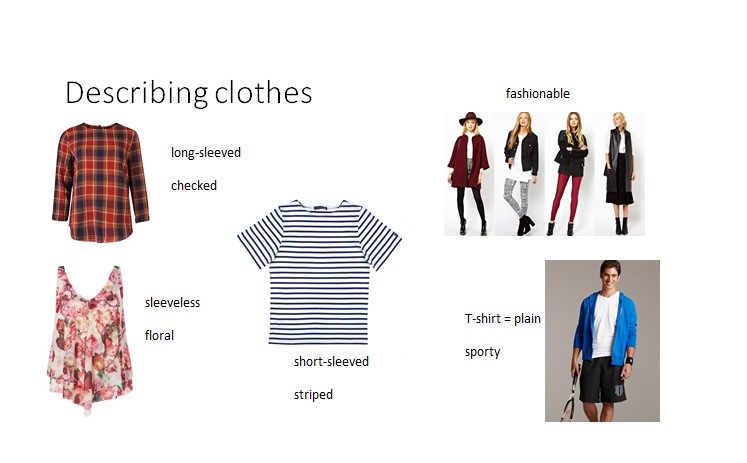
Vocabulary list
|
functional clothing |
fabrics/materials |
describing clothes |
|
an apron a bow tie mittens a pair of sandals a dressing gown a helmet a lifejacket a pair of trainers a wetsuit a tracksuit |
cotton denim nylon silk linen polyester rubber wool fur leather |
long-sleeved checked sleeveless floral short-sleeved striped plain sporty fashionable |
Worksheet
Worksheet: Vocabulary: clothes and fashion
1 Oral exercise. Describe the clothing of the person sitting next to you. Discuss your description with your neighbour. The following questions might help you:
- What is he/she wearing?
- Which fabrics are the clothing items made of?
- Which patterns do the items have?
- What about the length of the sleeves?
2 Read the following storyline.
Storyline: You all work in a company that creates functional clothing. The pictures in the PowerPoint presentation were the first designs for the clothing items, but your boss isn’t happy with the way the items look. He wants all of you to create a new clothing line. Each team has to create three new pieces. You can choose which ones you want to recreate. Each member of your team has to take up a different role after you’ve brainstormed about your ideas.
Roles
Fashion designer: you draw the different items with the colours and patterns you want the items to have. Make sure it looks good for your boss.
Reporter: you write down the descriptions of the clothing items. Make sure your boss knows which fabrics and materials you want to use and what the items will look like.
Graphic designer: you create the lay-out of the presentation of your clothing line. You can create a PowerPoint presentation or a magazine cover. Try to approach your target group.
Representative: you are the spokesperson of the group. You have to lay the ideas of your team in front of the boss and some other colleagues. They can ask you questions about your ideas.
Brainstorm about three clothing items

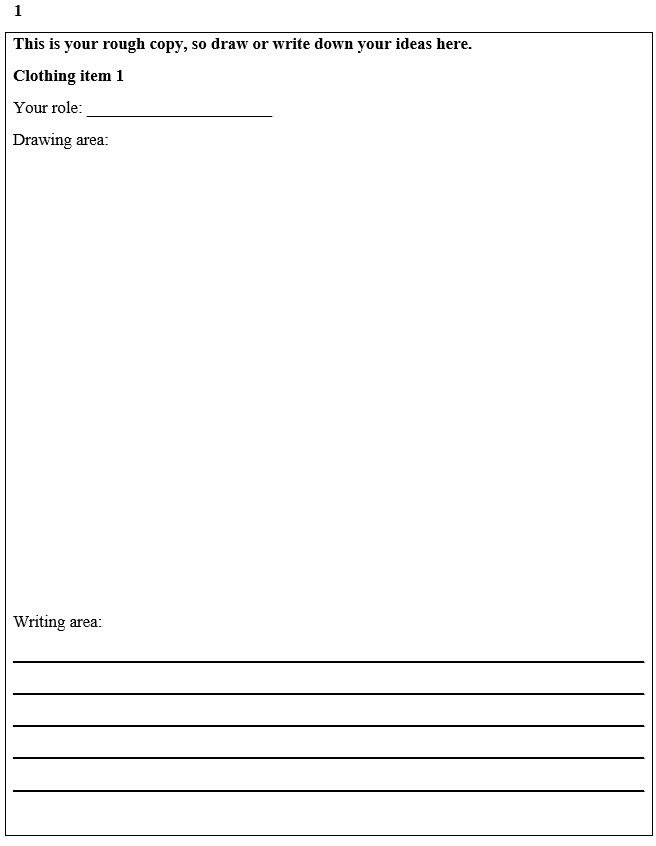
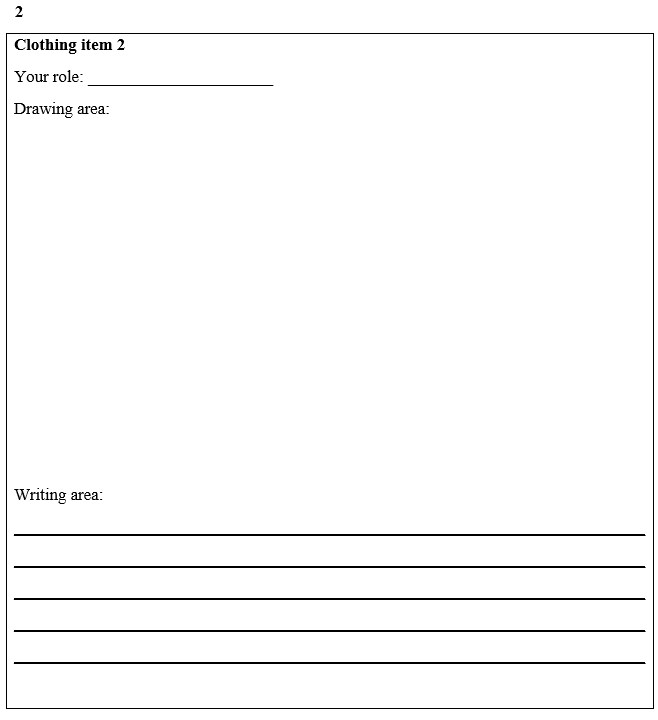
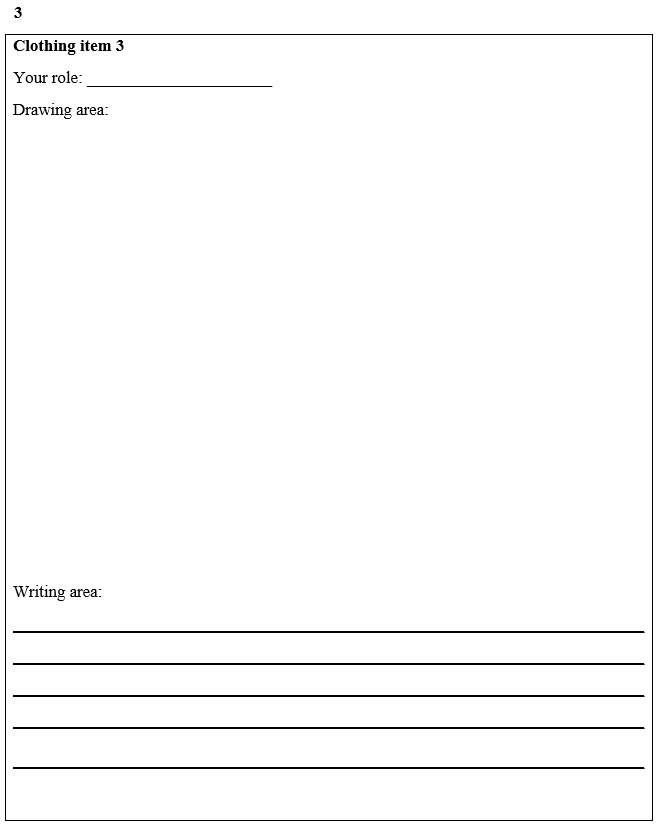
Creativity
Introduction
Creativity. What is it and what is its role in the English classroom? Is it only about creating game-like teaching methods or are there other ways to bring creativity in the classroom? In this article I will give my opinion on the role of creativity in the classroom by answering the above questions. Firstly I’ll talk about creativity and what it means to be a creative teacher. Next, I’ll talk about the role of creativity in the classroom and how that role can be fulfilled.
Background
A creative teacher
According to the English Oxford dictionary creativity or inventiveness is the use of imagination or original ideas to create something. A creative teacher then must be a person who uses his/her imagination to create something to be able to teach. If this is true, then each teacher has to invent new ways of teaching. I don’t think that is possible for each and every teacher. Some prefer to rely on the ideas of others, because the job of a teacher already is a stressful one. Maybe inventing new teaching methods isn’t the only thing that makes a teacher creative.
Let’s get back to the true role of a teacher, which shouldn’t be pushed to the background. That role is of course teaching pupils new subject matter that they can use in their lives. A teacher isn’t someone who has to invent fun activities to make pupils learn. That is a nice extra, but it’s not necessary. I’m not saying that school can’t be fun, but having fun isn’t the main objective of school. There are more ways to inspire pupils to learn and to motivate them. For example, by being an enthusiastic teacher that loves his/her subject.
What then makes a teacher creative? Not all teachers are very creative when it comes to inventing fun ways of learning. However, every teacher is/ has to be creative enough to find ways of teaching that match the levels and needs of his/her classes. I truly believe that that is worth a lot more than hundreds of creative lesson activities. If a teacher uses his/her talents in the classroom to support pupils, he/she is creative. An authentic teacher who sets an example and teaches others about the world outside the school building can leave a clear imprint on the pupils they won’t forget. To me that is very valuable.
The role of creativity in the classroom + examples
The role of creativity in the/my classroom is a major one. Creativity does play an important role to motivate pupils; to keep them engaged. The society we live in today expects people to be creative. Being able to think and find creative solutions to problems is one of the competences employers ask for nowadays. Teachers have to help pupils to use their imagination. Setting an example is the way to go, but how can teachers do that?
As I already mentioned, I don’t believe that the only way to be creative is by creating fun lessons. That shouldn’t be the main aim. Creativity can be entwined in a teacher’s lessons in various ways. If teachers show their pupils that they have a positive mindset about life and its problems and if they tell them that there is a solution to every problem, that is a good start. Next, a teacher should guide his/her pupils to look for solutions. Helping pupils to orientate, plan, do and reflect is a way of doing that. Teaching strategies to think clearly about something and solve problems is teaching pupils to be creative.
Conclusions
In conclusion, I can say that being a creative teacher doesn’t necessarily mean that you have to create new ways of teaching. Creativity is much more than that. A creative teacher is someone who finds ways of teaching that are appropriate for a specific group of pupils and who utilises his/her talents to create a motivating learning environment. Another conclusion is that creativity has a significant role in the classroom, because it motivates pupils. Motivation is the key to a good lesson. Other than that, it’s important because our society demands creative thinkers and teachers have to prepare their pupils for it.
Reference
Johnson, B. (2015, Septembre 28). "Creative Teacher" Is Not an Oxymoron. Retrieved from edutopia: https://www.edutopia.org/blog/creative-teacher-not-oxymoron-ben-johnson
Please check the CLIL for Secondary course at Pilgrims website.
Please check the English Language course at Pilgrims website.
Please check the Creative Methodology for the Classroom course at Pilgrims website.
Brief Acquaintanceship
Fauziah Ratna Hapsari, IndonesiaOn the Story of The Happy Prince by Oscar Wild (Chapter 3)
Iryna Wojtiuk, PolandVocabulary Lesson on Clothes and Fashion Combined with Productive Skills - Writing and Speaking
Lydia Ciola, Belgium